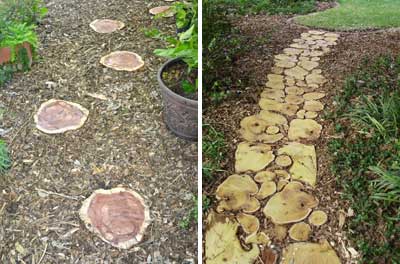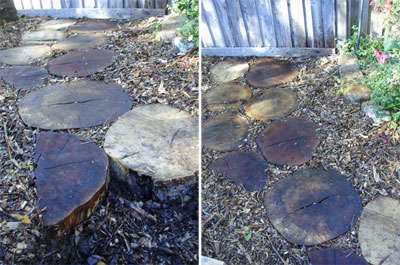Texas Tree Tips – November, 2011

Red cedar cookie walk. All photos by Steve Houser.
Cookie Walks Revisited
A cookie walk is not a new dance step — nor is it a bake sale. But it seemed to be a popular topic in last month’s e-gardens newsletter. For the sake of brevity, some of the finer details were not included, resulting in a wheelbarrow full of questions. As you may recall, logs of various sizes can be cut into slices and placed on the ground to form cookie walks or stepping cookies.

Left photo: Red cedar “stepping cookies”
Right photo: Bois d’arc cookie walk
Here are a few of the finer points about tree cookies:
Size The larger the diameter, the more stable the tree cookie. A 10- to 14-inch wide cookie makes a more stable walking surface than a 4- to 5-inch wide cookie. Likewise, a 3- to 6-inch thick cookie is more stable than a 1- to 2-inch thick cookie. Soil underneath a cookie, as opposed to mulch, offers more stability in the short term. In the long term, the mulch offers more stability as it mixes with the soil. However, the cookies may not stay level. Thin cookies will crack and split quicker than thick cookies.
Species All types of trees can be used for cookies, but avoid using black walnut cookies or black walnut chipped into mulch since they can contain juglone, an organic substance toxic to other plants.
Longevity The weaker-wooded tree species, such as willow, maple, and cottonwood, when not sealed or treated, will last a few years. Untreated hard-wooded species, such as oak, elm, and hickory, can last three years or more. The existing soil conditions can also play a role in the longevity of a tree cookie. Soils higher in organic matter and biological activity will encourage a more rapid decay.
Wood sealer Woodworkers often use an end-grain type of sealer or shellac that soaks into the wood fibers. Or, they may choose a more permanent sealer such as epoxy or varnish. Materials that soak into the wood will extend the cookie’s durability a few years and highlight the intricate grain patterns. While materials that seal the wood can extend cookie longevity, just be cautious not to use a material that might leach into the soil and affect nearby plants. The same is true for wood stains used to expose more of the grain on a lighter color of wood.
Live or dead trees Wood from either can be used, but cookies from dead trees may not last as long or look as good unless they are treated, sealed, or wet.
Oak Wilt If the tree is in the Red Oak family and died from Oak Wilt in the last year or two, the upper limbs may be used, but the trunk section should be burned or buried immediately. All other oak species are safe to use for cookies.
Arrangement Given the many species of trees and sizes, as well as the variance in wood color, there are many different potential layout patterns. A cookie walk with a winding pattern is more attractive and natural than a straight walkway — in most cases.
Tree cookies can be used for many other purposes, including coasters, trivets, or even to commemorate your favorite tree. The various wood grain patterns and colors represent nature’s artwork at its very best.
About the author: Steve Houser is a Dallas native with more than 30 years of experience as a consulting arborist and tree climber. He is the president of Arborilogical Services Inc., “The Experts Your Trees Deserve.” www.arborilogical.com.


